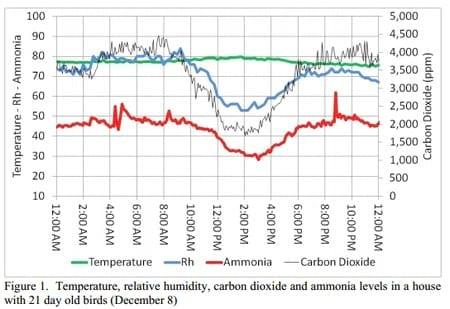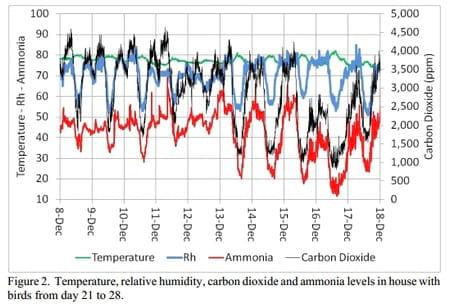Relative Humidity
Relative Humidity...The Best Measure of Overall Poultry House Air Quality
Published: April 11, 2012
By: Dr. Mike Czarick, Dr. Brian D. Fairchild (The University of Georgia)

Knowing how much to ventilate during cold weather is crucial to a poultry producer´s bottom line. Ventilating too little can lead to poor air/litter quality, resulting in bird health and performance issues. Ventilating too much can lead to drafty, dusty conditions and high heating costs. To best determine minimum ventilation fan runtime, farm managers should ideally monitor the three most important air quality variables: carbon dioxide, ammonia and relative humidity. Carbon dioxide is produced by both the birds and the house´s heating system. High carbon dioxide concentrations can lead to lethargic chicks and reduced weight gains and therefore should be kept below 5,000 ppm (ideally below 3,500 ppm). High ammonia concentrations can lead to poor feed conversions, reduced weight gains, and increased susceptibility to disease. In order to maximize bird performance and health, ammonia concentrations must be kept below 30 ppm (ideally below than 20 ppm) throughout the flock. Last but not least, relative humidity should be kept between 50 and 70%. Lower relative humidities will tend to result in a dusty house and high heating costs while higher relative humidities can lead to wet litter and high ammonia concentrations. Having meters to measure carbon dioxide, ammonia and relative humidity allows farm managers to set their minimum ventilation fans so they ventilate just enough to maintain proper air quality without over ventilating and driving up heating costs.
As you might suspect the problem with measuring all three air quality variables is cost. A reasonably accurate and reliable carbon dioxide meter typically costs between $300 and $500. Most ammonia meters used in the poultry industry cost between $500 and $1,000. The problem is their accuracy is questionable, require frequent calibration, have sensors that typically have to be replaced yearly and they generally cannot be left in a house for extended periods. On a more positive note, monitoring relative humidity is a fairly simple and inexpensive proposition. A reasonably accurate relative humidity meter that is capable of recording daily maximum and minimum relative humidity typically costs between $50 and $150. A relative humidity sensor can be added to most controllers for less than $300 and enables the controller, if the producer desires, to continually make changes to minimum ventilation rates to ensure the relative humidity stays within a specified range.
Though having access to all three types of meters would be helpful, realistically the only meter farm managers need to assess overall poultry house air quality is one that measures relative humidity. This is because for most of a cold weather flock, ammonia and carbon dioxide concentrations tend to closely follow relative humidity. That is, if the relative humidity is high, carbon dioxide and ammonia levels will tend to be high. If the relative humidity is low, carbon dioxide and ammonia levels will tend to be low as well. The close relationship among ammonia, carbon dioxide and relative humidity tends to be strongest with older birds and weakest during the first week or two of the flock. This is due to the substantial amount of carbon dioxide produced by most heating systems and the use of litter treatments which can result in a situation where the relative humidity is low and carbon dioxide high or the relative humidity is high and ammonia concentrations are low.

The close relationship among carbon dioxide, ammonia and relative humidity can be seen in Figures 1 and 2. Air temperature/Rh, carbon dioxide and ammonia were continually monitored in a 40´ X 500´ totally enclosed broiler house. Measurements were taken every 15 minutes starting when the birds were 18 days of age and continuing to the end of the flock at 39 days. Carbon dioxide and ammonia concentrations were measured through the use of a high accuracy photoacoustic gas analyzer ($40,000) while house temperature and relative humidity were being monitored using a poultry house environmental controller (Choretime II).
During the study period, ammonia and carbon dioxide concentrations tended to be within acceptable limits when the relative humidity was 60% or lower. Conversely, when the relative humidity was above 70%, ammonia and carbon dioxide levels tended to climb to what would generally be considered potentially harmful levels. There were of course exceptions. For instance, in Figure 3 on December 21 and 22 the relative humidity was high due to the fact it was raining but the carbon dioxide and ammonia levels were relatively low due to the fact that outside temperatures were fairly warm and a number of fans were operating to maintain proper house temperatures. But, the fact remains that for the most part a relative humidity of 70% or greater is a good indicator that minimum ventilation rates should be increased if optimal growing conditions are to be maintained.
It is important to note that most studies done on the effect that ammonia, carbon dioxide and relative humidity have on bird performance are done with birds exposed to high levels of one, not two or three at the same time. The problem is, as seen in Figures 1, 2, and 3, this is not what tends to occur in poultry houses. When ammonia is high, carbon dioxide and humidity are high as well. It is very possible the combination of high carbon dioxide, ammonia and relative humidity may have a more detrimental effect on bird performance than when just one of the three is high. Furthermore, when air exchange rates are too low (as indicated by high relative humidity, carbon dioxide and ammonia levels) pathogen levels in a house are likely to be higher than normal as well. The combination of low house air quality and higher than normal pathogen levels could very likely lead to an increased susceptibility to disease. It begs the question...How many of our production problems could be avoided if we simply used relative humidity as the basis for adjusting minimum ventilation fan runtime?
It is important to note that most studies done on the effect that ammonia, carbon dioxide and relative humidity have on bird performance are done with birds exposed to high levels of one, not two or three at the same time. The problem is, as seen in Figures 1, 2, and 3, this is not what tends to occur in poultry houses. When ammonia is high, carbon dioxide and humidity are high as well. It is very possible the combination of high carbon dioxide, ammonia and relative humidity may have a more detrimental effect on bird performance than when just one of the three is high. Furthermore, when air exchange rates are too low (as indicated by high relative humidity, carbon dioxide and ammonia levels) pathogen levels in a house are likely to be higher than normal as well. The combination of low house air quality and higher than normal pathogen levels could very likely lead to an increased susceptibility to disease. It begs the question...How many of our production problems could be avoided if we simply used relative humidity as the basis for adjusting minimum ventilation fan runtime?

Though there is not an exact correlation among relative humidity, ammonia and carbon dioxide the relationships are consistent enough to indicate that when a relative humidity of 60% or lower is maintained air quality tends to be within acceptable limits. Conversely, a relative humidity of 70% or higher tends to be a fairly accurate indicator of poor air quality. During the brooding period the relationships are not quite as strong so producers need to be aware that ammonia or carbon dioxide levels may still be at harmful levels even if the relative humidity is below 60%.
This article was originally published at UGA Cooperative Extension Poultry Housing Tips Vol. 24 no. 2, February, 2012. Engormix.com thanks the authors for this huge contribution.
Related topics
Authors:
Join to be able to comment.
Once you join Engormix, you will be able to participate in all content and forums.
* Required information
Would you like to discuss another topic? Create a new post to engage with experts in the community.
Create a postUniversity of Georgia
14 de abril de 2012
It is important to realize that we NEVER ventilate for oxygen in a poultry house. We ventilate for carbon dixoxide, carbon monoxide, ammonia, moisture, dust, etc...but not for oxygen.
11 de abril de 2012
It is really good article. By acting upon the guidline given can lower the incidence of diseases particularly respiratory diseases. In winter there is low humidity also in some parts of the world, so to relate the level of humidity with the levels of CO2, Ammonia needs more study.
However article is helpfull in managing minimum ventilation for production of healthy poultry. If oxygen levels are also taken care of, will help in better performance.
In my opinion to bear some cost of heating by extra ventilation will be more benificial, but must be governed by the rules mentioned in article.
Syed Maqsood Haider Jaffery
PhD scholar (Pathology)
Maxies
18 de abril de 2012
Dear Dr. Mike & Dr. Brain, Thank you for your good work. You have clearly shown the correlation among 3 important parameters that affect the growth performance of broilers in closed houses. This work also shows how to obtain comfort indicators by simply measuring RH which costs very much less.
12 de abril de 2012
its good indicator of problems that are going to come however ventilation and air speed that is the oxygen getting in the poultry house and the carbon dioxide going out the house is the most important factor to consider













.jpg&w=3840&q=75)